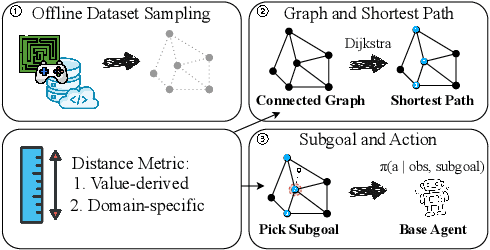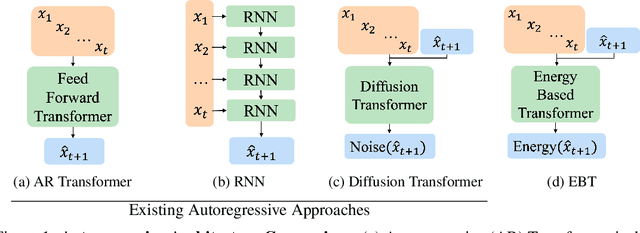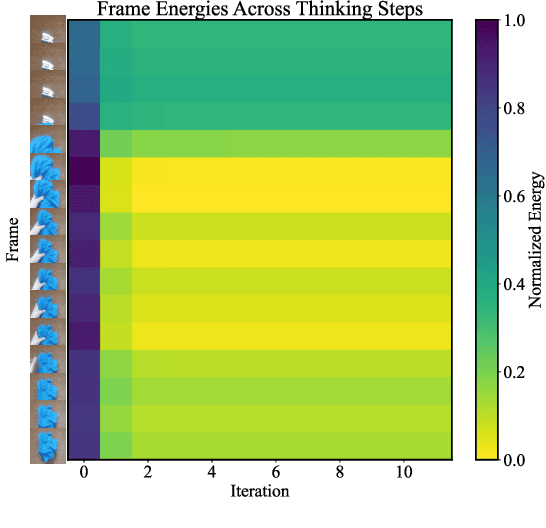Yilun Du
Derek
Generalizable Reasoning through Compositional Energy Minimization
Oct 23, 2025Abstract:Generalization is a key challenge in machine learning, specifically in reasoning tasks, where models are expected to solve problems more complex than those encountered during training. Existing approaches typically train reasoning models in an end-to-end fashion, directly mapping input instances to solutions. While this allows models to learn useful heuristics from data, it often results in limited generalization beyond the training distribution. In this work, we propose a novel approach to reasoning generalization by learning energy landscapes over the solution spaces of smaller, more tractable subproblems. At test time, we construct a global energy landscape for a given problem by combining the energy functions of multiple subproblems. This compositional approach enables the incorporation of additional constraints during inference, allowing the construction of energy landscapes for problems of increasing difficulty. To improve the sample quality from this newly constructed energy landscape, we introduce Parallel Energy Minimization (PEM). We evaluate our approach on a wide set of reasoning problems. Our method outperforms existing state-of-the-art methods, demonstrating its ability to generalize to larger and more complex problems. Project website can be found at: https://alexoarga.github.io/compositional_reasoning/
Controllable Video Synthesis via Variational Inference
Oct 09, 2025Abstract:Many video workflows benefit from a mixture of user controls with varying granularity, from exact 4D object trajectories and camera paths to coarse text prompts, while existing video generative models are typically trained for fixed input formats. We develop a video synthesis method that addresses this need and generates samples with high controllability for specified elements while maintaining diversity for under-specified ones. We cast the task as variational inference to approximate a composed distribution, leveraging multiple video generation backbones to account for all task constraints collectively. To address the optimization challenge, we break down the problem into step-wise KL divergence minimization over an annealed sequence of distributions, and further propose a context-conditioned factorization technique that reduces modes in the solution space to circumvent local optima. Experiments suggest that our method produces samples with improved controllability, diversity, and 3D consistency compared to prior works.
Test-Time Graph Search for Goal-Conditioned Reinforcement Learning
Oct 08, 2025



Abstract:Offline goal-conditioned reinforcement learning (GCRL) trains policies that reach user-specified goals at test time, providing a simple, unsupervised, domain-agnostic way to extract diverse behaviors from unlabeled, reward-free datasets. Nonetheless, long-horizon decision making remains difficult for GCRL agents due to temporal credit assignment and error accumulation, and the offline setting amplifies these effects. To alleviate this issue, we introduce Test-Time Graph Search (TTGS), a lightweight planning approach to solve the GCRL task. TTGS accepts any state-space distance or cost signal, builds a weighted graph over dataset states, and performs fast search to assemble a sequence of subgoals that a frozen policy executes. When the base learner is value-based, the distance is derived directly from the learned goal-conditioned value function, so no handcrafted metric is needed. TTGS requires no changes to training, no additional supervision, no online interaction, and no privileged information, and it runs entirely at inference. On the OGBench benchmark, TTGS improves success rates of multiple base learners on challenging locomotion tasks, demonstrating the benefit of simple metric-guided test-time planning for offline GCRL.
Slm-mux: Orchestrating small language models for reasoning
Oct 06, 2025Abstract:With the rapid development of language models, the number of small language models (SLMs) has grown significantly. Although they do not achieve state-of-the-art accuracy, they are more efficient and often excel at specific tasks. This raises a natural question: can multiple SLMs be orchestrated into a system where each contributes effectively, achieving higher accuracy than any individual model? Existing orchestration methods have primarily targeted frontier models (e.g., GPT-4) and perform suboptimally when applied to SLMs. To address this gap, we propose a three-stage approach for orchestrating SLMs. First, we introduce SLM-MUX, a multi-model architecture that effectively coordinates multiple SLMs. Building on this, we develop two optimization strategies: (i) a model selection search that identifies the most complementary SLMs from a given pool, and (ii) test-time scaling tailored to SLM-MUX. Our approach delivers strong results: Compared to existing orchestration methods, our approach achieves up to 13.4% improvement on MATH, 8.8% on GPQA, and 7.0% on GSM8K. With just two SLMS, SLM-MUX outperforms Qwen 2.5 72B on GPQA and GSM8K, and matches its performance on MATH. We further provide theoretical analyses to substantiate the advantages of our method. In summary, we demonstrate that SLMs can be effectively orchestrated into more accurate and efficient systems through the proposed approach.
Equilibrium Matching: Generative Modeling with Implicit Energy-Based Models
Oct 02, 2025Abstract:We introduce Equilibrium Matching (EqM), a generative modeling framework built from an equilibrium dynamics perspective. EqM discards the non-equilibrium, time-conditional dynamics in traditional diffusion and flow-based generative models and instead learns the equilibrium gradient of an implicit energy landscape. Through this approach, we can adopt an optimization-based sampling process at inference time, where samples are obtained by gradient descent on the learned landscape with adjustable step sizes, adaptive optimizers, and adaptive compute. EqM surpasses the generation performance of diffusion/flow models empirically, achieving an FID of 1.90 on ImageNet 256$\times$256. EqM is also theoretically justified to learn and sample from the data manifold. Beyond generation, EqM is a flexible framework that naturally handles tasks including partially noised image denoising, OOD detection, and image composition. By replacing time-conditional velocities with a unified equilibrium landscape, EqM offers a tighter bridge between flow and energy-based models and a simple route to optimization-driven inference.
Selective Underfitting in Diffusion Models
Oct 01, 2025Abstract:Diffusion models have emerged as the principal paradigm for generative modeling across various domains. During training, they learn the score function, which in turn is used to generate samples at inference. They raise a basic yet unsolved question: which score do they actually learn? In principle, a diffusion model that matches the empirical score in the entire data space would simply reproduce the training data, failing to generate novel samples. Recent work addresses this question by arguing that diffusion models underfit the empirical score due to training-time inductive biases. In this work, we refine this perspective, introducing the notion of selective underfitting: instead of underfitting the score everywhere, better diffusion models more accurately approximate the score in certain regions of input space, while underfitting it in others. We characterize these regions and design empirical interventions to validate our perspective. Our results establish that selective underfitting is essential for understanding diffusion models, yielding new, testable insights into their generalization and generative performance.
Hybrid Diffusion for Simultaneous Symbolic and Continuous Planning
Sep 26, 2025Abstract:Constructing robots to accomplish long-horizon tasks is a long-standing challenge within artificial intelligence. Approaches using generative methods, particularly Diffusion Models, have gained attention due to their ability to model continuous robotic trajectories for planning and control. However, we show that these models struggle with long-horizon tasks that involve complex decision-making and, in general, are prone to confusing different modes of behavior, leading to failure. To remedy this, we propose to augment continuous trajectory generation by simultaneously generating a high-level symbolic plan. We show that this requires a novel mix of discrete variable diffusion and continuous diffusion, which dramatically outperforms the baselines. In addition, we illustrate how this hybrid diffusion process enables flexible trajectory synthesis, allowing us to condition synthesized actions on partial and complete symbolic conditions.
Energy-Based Transformers are Scalable Learners and Thinkers
Jul 02, 2025



Abstract:Inference-time computation techniques, analogous to human System 2 Thinking, have recently become popular for improving model performances. However, most existing approaches suffer from several limitations: they are modality-specific (e.g., working only in text), problem-specific (e.g., verifiable domains like math and coding), or require additional supervision/training on top of unsupervised pretraining (e.g., verifiers or verifiable rewards). In this paper, we ask the question "Is it possible to generalize these System 2 Thinking approaches, and develop models that learn to think solely from unsupervised learning?" Interestingly, we find the answer is yes, by learning to explicitly verify the compatibility between inputs and candidate-predictions, and then re-framing prediction problems as optimization with respect to this verifier. Specifically, we train Energy-Based Transformers (EBTs) -- a new class of Energy-Based Models (EBMs) -- to assign an energy value to every input and candidate-prediction pair, enabling predictions through gradient descent-based energy minimization until convergence. Across both discrete (text) and continuous (visual) modalities, we find EBTs scale faster than the dominant Transformer++ approach during training, achieving an up to 35% higher scaling rate with respect to data, batch size, parameters, FLOPs, and depth. During inference, EBTs improve performance with System 2 Thinking by 29% more than the Transformer++ on language tasks, and EBTs outperform Diffusion Transformers on image denoising while using fewer forward passes. Further, we find that EBTs achieve better results than existing models on most downstream tasks given the same or worse pretraining performance, suggesting that EBTs generalize better than existing approaches. Consequently, EBTs are a promising new paradigm for scaling both the learning and thinking capabilities of models.
Product of Experts for Visual Generation
Jun 10, 2025Abstract:Modern neural models capture rich priors and have complementary knowledge over shared data domains, e.g., images and videos. Integrating diverse knowledge from multiple sources -- including visual generative models, visual language models, and sources with human-crafted knowledge such as graphics engines and physics simulators -- remains under-explored. We propose a Product of Experts (PoE) framework that performs inference-time knowledge composition from heterogeneous models. This training-free approach samples from the product distribution across experts via Annealed Importance Sampling (AIS). Our framework shows practical benefits in image and video synthesis tasks, yielding better controllability than monolithic methods and additionally providing flexible user interfaces for specifying visual generation goals.
Self-Adapting Improvement Loops for Robotic Learning
Jun 07, 2025Abstract:Video generative models trained on expert demonstrations have been utilized as performant text-conditioned visual planners for solving robotic tasks. However, generalization to unseen tasks remains a challenge. Whereas improved generalization may be facilitated by leveraging learned prior knowledge from additional pre-collected offline data sources, such as web-scale video datasets, in the era of experience we aim to design agents that can continuously improve in an online manner from self-collected behaviors. In this work we thus propose the Self-Adapting Improvement Loop (SAIL), where an in-domain video model iteratively updates itself on self-produced trajectories, collected through adaptation with an internet-scale pretrained video model, and steadily improves its performance for a specified task of interest. We apply SAIL to a diverse suite of MetaWorld tasks, as well as two manipulation tasks on a real robot arm, and find that performance improvements continuously emerge over multiple iterations for novel tasks initially unseen during original in-domain video model training. Furthermore, we discover that SAIL is surprisingly robust regarding if and how the self-collected experience is filtered, and the quality of the initial in-domain demonstrations. Through adaptation with summarized internet-scale data, and learning through online experience, we thus demonstrate a way to iteratively bootstrap a high-performance video model for solving novel robotic tasks through self-improvement.
 Add to Chrome
Add to Chrome Add to Firefox
Add to Firefox Add to Edge
Add to Edge